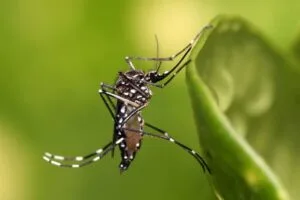GS Paper II – Health |
Highlights :
- Mitigating mosquito-borne illnesses using evidence-based therapies has great promise for relieving pressure on our healthcare systems and boosting productivity. To tackle the Aedes-borne triple epidemic of dengue, chikungunya, and Zika, we need to revive and support creative vector control programs throughout India.
- Dengue, a well-known threat in India, is estimated to cause approximately 28,300 crore in direct costs annually and 5.68 lakh years of premature mortality.
- The wMel Strategy uses a naturally occurring bacterium called Wolbachia found in fruit flies (Drosophila melanogaster).
- Several countries have effectively implemented both population replacement and suppression strategies.
- There isn’t a running wMel mosquito release program in India at the moment.
- According to a recent ICMR report, Wolbachia was discovered in Aedes in northeastern India spontaneously.
Discussing dengue fever:
Dengue, sometimes known as break-bone fever, is a virus spread by mosquitoes. It is more prevalent in urban and semi-urban areas of tropical and subtropical climates. Although the virus usually only causes moderate illness or no symptoms at all, dengue infections can also occasionally result in more serious cases or even death.
Disease transmission:
If an infected Aedes mosquito carries a flavivirus pathogen, a bite from that mosquito can result in dengue fever.
Aedes aegypti or Aedes albopictus are two examples of the Aedes species of mosquitoes.
Usually, 3 to 14 days following infection, it starts to show symptoms.
Except in cases where it is transmitted from a pregnant woman to her unborn child, dengue is not spread from person to person.
Dengue fever statistics :
For a variety of causes, dengue fever is frequent in tropical and subtropical areas.
Tropical and subtropical regions have warm, humid weather.
Rise in Deaths from Dengue Fever: According to the World Health Organization, dengue killed almost 20,000 individuals in 2000 (WHO).
Current Year Data: It is anticipated that at least 40,000 people will die this year, which will be a notable increase in the number of deaths.
Compare with Malaria: WHO data show that between 2000 and 2022, the number of deaths from malaria reduced by 30%.
Impact of dengue fever in India between 1950 and 1960: Southeast Asian nations were the primary epicenters of dengue fever.
It began to spread globally in 1970.
By 2012–2013, the disease has spread to India.
Trend by Decade :
In India, the number of months that are ideal for dengue transmission has increased yearly by 1.69% between 1951–1960 and 2012–21.
The duration was 5.6 months.
India’s dengue cases: In India, the number of dengue cases exceeds lakhs annually.
It puts a great deal of strain on the healthcare system in India.
Dengue fever incidence dropped by 56–60% during pandemic 2020.
Highest Dengue Cases: In 2021, Dengue cases peaked.
In 2022, the case was denied once more.
Factors Associated with the Spread of Dengue Fever, Climate Change, and Mosquito Range:
- Increased sensitivity to temperature: Mosquito breeding is facilitated by higher temperatures and humidity.
Aedes may spread to southern Europe and the US because to current climatic patterns. - Favourable state: Dengue is easier to spread in urban settings since there are more mosquitoes there to feed on.
In formerly unaffected areas like Bangladesh, India, California, southern Europe, and subtropical Africa, dengue incidence are on the rise. - Water Storage Practices:
Aedes mosquitoes reproduce in stagnant water, which is frequently found in containers and other water storage vessels.
Open containers and abandoned water sources are examples of improper water storage practices that provide mosquitoes with perfect breeding grounds and increase the incidence of dengue transmission. - Ineffective Vector Control: Inadequate vector control efforts, like mosquito surveillance and extermination campaigns, lead to the dengue virus’s ongoing spread.
- Inadequate infrastructure and resources: In certain areas, inadequate infrastructure and resources make it difficult to efficiently manage mosquito populations and stop dengue outbreaks.
Experimental Approaches to Dengue Management :
Singapore’s Method:
Singapore employs both conventional techniques and cutting-edge tactics, such as the release of Wolbachia-infected mosquitoes.
Singapore has been running a state-of-the-art dengue program since 2016.
This approach presents a viable replacement for conventional mosquito control, especially when paired with vaccine development.-
Indian Dengue Fever Vaccine: As of right now, India has no licensed vaccines.
Still, there are ongoing initiatives for “Dengusiil.” -
The effects of Wolbachia
Colombian trials: When wolbachia-infected mosquitoes are released, the number of dengue cases has been significantly reduced, according to these trials.
Brazil is going to be home to the biggest Wolbachia-mosquito factory in the world.
This program will aid in the fight against dengue in other areas.
Explore our courses: https://apnipathshala.com/courses/
Explore Our test Series: https://tests.apnipathshala.com/










